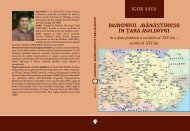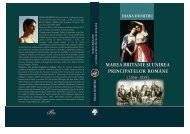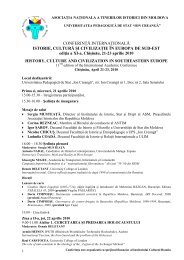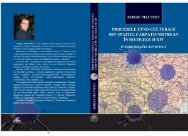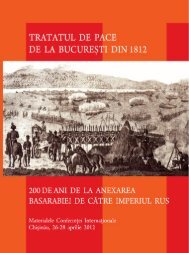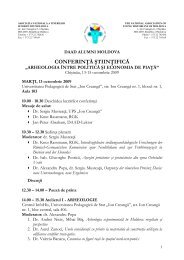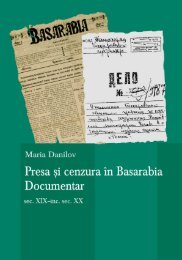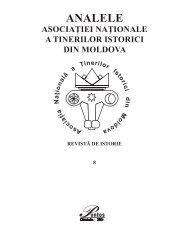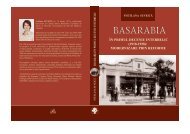LUCIA SAVA, Viaţa cotidiană în oraşul Chişinău la - Asociatia ...
LUCIA SAVA, Viaţa cotidiană în oraşul Chişinău la - Asociatia ...
LUCIA SAVA, Viaţa cotidiană în oraşul Chişinău la - Asociatia ...
You also want an ePaper? Increase the reach of your titles
YUMPU automatically turns print PDFs into web optimized ePapers that Google loves.
<strong>Viaţa</strong> <strong>cotidiană</strong> <strong>în</strong> <strong>oraşul</strong> <strong>Chişinău</strong> <strong>la</strong> <strong>în</strong>ceputul secoului al XX-lea (1900-1918)<br />
225<br />
the periodical press time as an inevitable triumph of the principle of nationalities,<br />
whose moral and political force could not defeat a hostile propaganda<br />
episodes of rising military and occupied or deceived,... as a triumphant manifestation<br />
of the power of life and origin of self-confidence in the future”, „a<br />
ray of light immortal soothes our souls and awakens hopes.”<br />
The transition from old to new structures Romanian administrative institutions,<br />
however, was accompanied by a certain social-psychological distress<br />
noted at the time.<br />
1.1.5. The living environment<br />
During its historical evolution, Chisinau has developed itself, there has<br />
been spontaneous, but is also the region where the product was born and has<br />
entered a process of interdependence, mutual exchanges.<br />
The Urbanization of Chisinau, which is experiencing a boost from the<br />
twentieth century, the city organization requires continuous increase from<br />
center to periphery. Over time, the city has stepped functional structure, and<br />
has expanded its areas of influence, gradually becoming the main information<br />
center, most dynamic engine of economic, social and cultural development<br />
of society which it belongs. In the period studied, the city is a complex<br />
system consisting of separate components connected by inter-re<strong>la</strong>tionships<br />
that define the organizational structure and composition of the urban environment.<br />
Regarded as one of the <strong>la</strong>rgest cities of Europe (Şt. Ciobanu), but a real<br />
city and „province”, Chisinau seems strikingly resembled much of Constantinople,<br />
„sleepy and apathetic city” (I. Caşu, E. Dragnev, V. Pâs<strong>la</strong>riuc), where<br />
daily life is often subject to heavy testing, such as providing food, public<br />
transport, increased crime, etc.<br />
Like most cities of the Russian Empire, Chisinau occupy a <strong>la</strong>rge territory,<br />
and the buildings were separated by streets, grouped in neighborhoods.<br />
The pace of life known a more exciting in the city center, where they were<br />
concentrated most representative public buildings: City Hall, cathedral, court,<br />
theater, cinema, library, shops, banks, etc.. And p<strong>la</strong>ces of entertainment:<br />
pubs, cafes, etc. In this part of the city appear elements of upgrading and<br />
transforming the city into a true urban center. At city limits look like this: the<br />
narrow and winding streets with small houses covered with shingle and reed,<br />
surrounded by gardens and orchards. They were inhabited by low-income<br />
strata and poor urban popu<strong>la</strong>tions.<br />
Compared to major European cities, where even in the suburbs come



